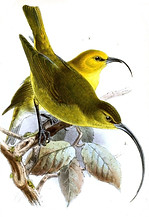Creature
Fast Facts
Introducing you to extinct species.

THE
KAUA'I 'AKIALOA
1. The Kaua'i 'akialoa, Akialoa stejnegeri, was a member of the Hawaiian honeycreeper family. 2. It was 7.5 inches long, with one third of its length being its unique, down curved bill. 3. The male was olive green and yellow and the female was green-gray and had a shorter bill. 4. It was native to Kauai, Hawaii and lived in the forests above 1,148 feet above sea level. 5. The long curved bill helped this honeycreeper eat nectar from lobelias and ʻohiʻa blossoms. It also helped search for insects under moss. 6. In 1896 the Apororhynchus hemignathi parasite was discovered in the intestine on the Kaua'i 'akialoa. 7. They were never abundant, but the biggest killer of this and many Hawaiian bird species was malaria brought by mosquitos traveling on whaling ships and other avian diseases. 8. Hawaii is considered the "bird extinction capital of the world" because 95 bird species have gone extinct on the Hawaiian Islands since people arrived there.
Extinction
Cometh
Facing the light at the end of the tunnel
EXTINCTION DATE
1969
Polynesians first arrived in the Hawaiian Islands around 400 A.D. They did have an effect on the native wildlife. They cleared forests to make their farms and villages. The animals they brought with them, such as mongooses, dogs, rats, and chickens, took an even greater toll of native birds because many birds nested on the ground and had no fear of predators. In fact, Hawaii only had one mammal, the Hawaiian hoary bat. The first Hawaiians did hunt the colorful birds to create elaborate feather cloaks and hats that showed a chief's status. Native Hawaiians would capture colorful birds, pluck the needed feathers and release the birds. On January 18, 1778 Captain Cook became the first European to set foot in Hawaii. The biggest effects on the native birds started in 1826, when American whalers started dumping bilge water from their ships, thus bringing mosquitos to the Hawaiian Islands. 35 additional species went extinct after the arrival of whalers. The Americans also introduced guns to Hawaiians, and the pluck and release system of bird hunting was replaced by hunts that would kill up to 1,000 birds. The Kaua'i 'akialoa survived many of the obstacles that made so many Hawaiian birds go extinct because they lived in the higher forests of Kauai where it was too cold for mosquitoes. These honeycreepers would sometimes descend into the lower forests to eat insects. It was during these descents into lower forests that they came into contact with avian diseases brought by chickens and the deadly avian malaria brought by mosquitos. In 1903 the Forest Reserve Act was created to protect the forests and rivers on the island. In 1907, the Hawaiian Territorial Legislature passed a law to protect all native perching birds. In 1967, the Kaua'i 'akialoa was added to the Endangered Species list. From 1968 - 1972, efforts were made to locate the Kaua'i 'akialoa, but none were found. The last official sighting was in 1969. This honeycreeper was officially declared extinct in 2021 by the U.S. Fish & Wildlife Service. Could Kaua'i 'akialoa live on the Hawaiian Islands today? Although Jurassic Park is fiction, scientists are working on several de-extinction projects. In fact, in 2003 scientists did bring back the extinct Pyrenean ibex, a type of wild goat, for 7 minutes before it died, showing de-extinction is possible. The Kaua'i 'akialoa could be a candidate. Scientists would use museum specimens to get DNA to try to bring them back to life. Many efforts have been made in Hawaii since the Kaua'i 'akialoa's extinction. There have been efforts to eradicate rats and invasive species from the environment. Scientists have also been working to control avian diseases and thwart the avian malaria that has affected so many species in Hawaii. If the Kaua'i 'akialoa was brought back from extinction, could it survive in its native homeland of Hawaii?
COMING SOON
The kaua'i akialoa's Lazarus tale has yet to be written, but what adventures will await it when it returns to the islands of Hawaii? Stay tuned to find out.
More to Explore
All answers lead to more questions

Painting of kaua'i akialoa
Image from Wikipedia
VIDEOS & ADDITIONAL INFO
Biogeography of Hawaii - Atlas Pro Video

Specimen from Bishop Museum in Honolulu, Hawaii
Image from Wikipedia
Painting of
kaua'i akialoa
Image from Wikipedia




Photo of kaua'i akialoa
Image from Birds of the World
Kaua'i akialoa illustration
Image from Birds of the World
Memorial stamp
Image from Bird Writer

Endangered Hawaiian birds
Image from Birdorable Planet

'I'iwi
Image from State of the Birds

‘Alae ‘Ula
Image from ABC Birds

Endangered Hawaiian birds
Image from Pinterest






